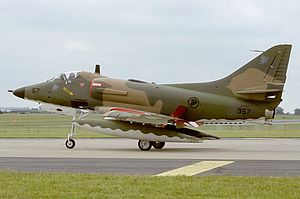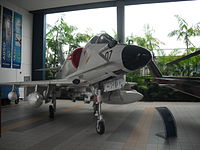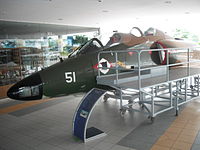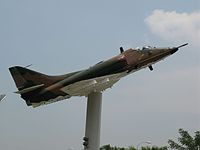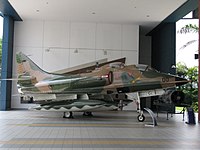
The General Dynamics F-16 Fighting Falcon is a single-engine multirole fighter aircraft originally developed by General Dynamics for the United States Air Force (USAF). Designed as an air superiority day fighter, it evolved into a successful all-weather multirole aircraft. Over 4,600 aircraft have been built since production was approved in 1976. Although no longer being purchased by the U.S. Air Force, improved versions are being built for export customers. In 1993, General Dynamics sold its aircraft manufacturing business to the Lockheed Corporation, which in turn became part of Lockheed Martin after a 1995 merger with Martin Marietta.

The Northrop Grumman E-2 Hawkeye is an American all-weather, carrier-capable tactical airborne early warning (AEW) aircraft. This twin-turboprop aircraft was designed and developed during the late 1950s and early 1960s by the Grumman Aircraft Company for the United States Navy as a replacement for the earlier, piston-engined E-1 Tracer, which was rapidly becoming obsolete. The aircraft's performance has been upgraded with the E-2B and E-2C versions, where most of the changes were made to the radar and radio communications due to advances in electronic integrated circuits and other electronics. The fourth major version of the Hawkeye is the E-2D, which first flew in 2007. The E-2 was the first aircraft designed specifically for its role, as opposed to a modification of an existing airframe, such as the Boeing E-3 Sentry. Variants of the Hawkeye have been in continuous production since 1960, giving it the longest production run of any carrier-based aircraft.

The Douglas A-4 Skyhawk is a single-seat subsonic carrier-capable light attack aircraft developed for the United States Navy and United States Marine Corps in the early 1950s. The delta-winged, single turbojet engined Skyhawk was designed and produced by Douglas Aircraft Company, and later by McDonnell Douglas. It was originally designated A4D under the U.S. Navy's pre-1962 designation system.
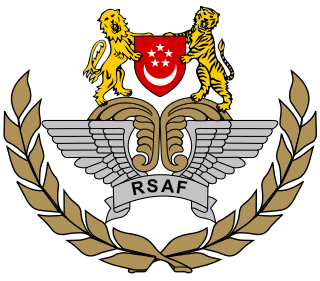
The Republic of Singapore Air Force (RSAF) is the aerial service branch of the Singapore Armed Forces (SAF). It was first established on 1 September 1968 as the Singapore Air Defence Command (SADC), before being renamed to its current iteration on 1 April 1975.
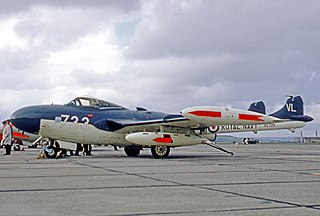
The de Havilland Sea Venom is a British postwar carrier-capable jet aircraft developed from the de Havilland Venom. It served with the Royal Navy Fleet Air Arm and with the Royal Australian Navy. The French Navy operated the Aquilon, developed from the Sea Venom FAW.20, built under licence by SNCASE (Sud-Est).

The SIAI-Marchetti S.211 is a turbofan-powered military trainer aircraft designed and originally marketed by Italian aviation manufacturer SIAI-Marchetti.

The Aermacchi M-346 Master is a family of military twin-engine transonic advanced jet trainers and light combat aircraft. Originally co-developed with Yakovlev as the Yak/AEM-130, the partnership was dissolved in 2000 and the then Alenia Aermacchi proceeded to separately develop the M-346 Master, while Yakolev continued work on the Yakovlev Yak-130. The first flight of the M-346 was performed in 2004. The type is currently operated by the air forces of Italy, Israel, Singapore, and Poland. Since 2016 the manufacturer became Leonardo-Finmeccanica as Alenia Aermacchi merged into the new Finmeccanica, finally rebranded as Leonardo in 2017.
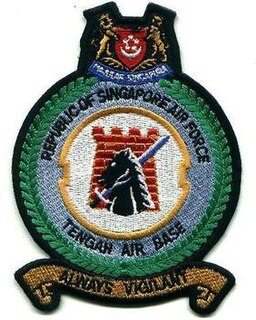
The Tengah Air Base is a military airbase of the Republic of Singapore Air Force (RSAF) located in the Western Water Catchment, in the western part of Singapore.

The 143 Squadron "Phoenix" of the Republic of Singapore Air Force currently operates twelve F-16 Fighting Falcon Block 52. Based in Tengah Airbase, the squadron's motto is "We Dare".

The 145 Squadron "Hornet" is a strike fighter squadron of the Republic of Singapore Air Force based currently at Changi Airbase (East) which is a new airbase, opened in 2004, to the east of Singapore Changi Airport on reclaimed land. With the hornet as its mascot, the squadron's motto is "Swift & Valiant".

The Lockheed Martin A-4AR Fightinghawk is a major upgrade of the McDonnell Douglas A-4M Skyhawk attack aircraft developed for the Argentine Air Force which entered service in 1998. The program was named Fightinghawk in recognition of the F-16 Fighting Falcon, which was the source of its new avionics.

The 120 Squadron "Kestrel" is a helicopter squadron of the Republic of Singapore Air Force based at Sembawang Air Base. First formed in 1969, it is the first and oldest RSAF operational squadron in service. The squadron goes by the motto of "Strive To Achieve". Since 2006, it operates the AH-64D Apache Longbow attack helicopter and has participated in Singapore's National Day Parade together with 127 Squadron CH-47SD Chinook for the traditional National Flag Fly Pass.
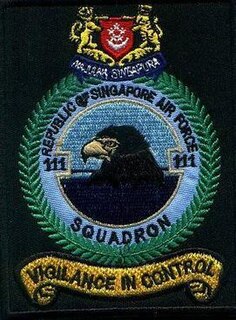
The 111 Squadron "Jaeger" was formed when the Republic of Singapore Air Force acquired four Grumman E-2C Hawkeye Airborne Early Warning aircraft in 1987. Based at Tengah Air Base, its primary function is to perform airborne surveillance and early warning. Other functions include Aircraft Intercept Control, Surface Surveillance, Search and Rescue and Air Traffic Control.

The Black Knights is the official aerobatics team of the Republic of Singapore Air Force (RSAF) featuring six F-16C Fighting Falcons in formation flight. The Black Knights' emblem is sported on the red vertical tail of each of the team's aircraft and the team's name is emblazoned on both sides of the aircraft which are painted in red and white – the national colours of Singapore.
ST Aerospace , is the Commercial Aerospace entity of ST Engineering. Headquartered in Singapore, it has international offices and facilities located at aviation hubs in Asia Pacific, Europe and the United States. ST Engineering's Commercial Aerospace business provides solutions for practically every stage of an aircraft life cycle, from design and engineering, original equipment manufacturing, nose-to-tail aftermarket and maintenance services as well as assets management and leasing. And also through passenger-to-freighter conversion or refurbishment, ST Engineering Aerospace gives ageing aircraft a new lease of life.
Cazaux Air Base is a French Air and Space Force base. The base is located in the village of Cazaux, part of the town of La Teste-de-Buch, and is approximately 35 miles (56 km) southwest of Bordeaux.

The McDonnell Douglas A-4G Skyhawk is a variant of the Douglas A-4 Skyhawk attack aircraft developed for the Royal Australian Navy (RAN). The model was based on the A-4F variant of the Skyhawk, and was fitted with slightly different avionics as well as the capacity to operate AIM-9 Sidewinder air-to-air missiles. The RAN received ten A-4Gs in 1967 and another ten in 1971, and operated the type from 1967 to 1984.
The 142 Squadron "Gryphon" of the Republic of Singapore Air Force is a fighter-bomber squadron based at Paya Lebar Air Base, the squadron goes by the motto "Honour and Glory" with the Gryphon adopted as its mascot. According to IHS Janes, it is the second Singapore-based F-15SG Squadron.
